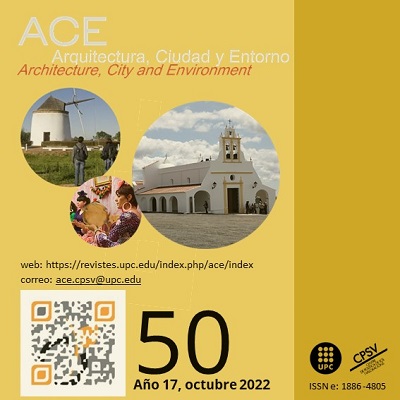Developing the Prototype of the Climate-Responsive Building Form: Merging Passive and Active Space Cooling Strategies
DOI:
https://doi.org/10.5821/ace.17.50.11406Keywords:
Natural ventilation, passive and active cooling, hybrid mode, climate responsive buildingAbstract
This article presents the considered capabilities to improve space cooling energy efficiency in the Mediterranean climate ambience by merging and optimizing selected natural ventilative techniques. The first part of the analysis defines a set of control strategies with a multilevel design approach based on a specific configuration of cross ventilation and fan-assisted advanced natural ventilation (ANV) centre-in, edge-out (C-E) form. The objective is to take advantage of principally lower nocturnal temperature ranges and to reflect such a potential on the reduction of the day-time cooling energy loads. The second part of this paper examines the integration of defined control strategies into a climate responsive building form of a mid-rise office-type building positioned in the city of Barcelona (Spain). In the last part of the study, the building model is exposed to present weather conditions in the building performance simulation environment while the general control and adjustments of established indoor airflow patterns are done by computational fluid dynamics (CFD) analyses. Performed simulations achieves the yearly reduction of space cooling energy loads by 65.3%. The night-time operation takes the large part of 50.5%, using lower nocturnal outdoor temperatures due to being less affected by current climate change effects. Based on the use of the renewable energy source, the designed climate responsive building form, named D-Fence model, represents the bioclimatic approach with the examined capabilities in cutting cooling energy demands in the Mediterranean climate ambiance.
Published
Issue
Section
License
| INTELECTUAL PROTECTION CRITERIA |
At this moment, it is count with the "Oficina Española de Patentes y Marcas", while global protection it is being processed by the World Intelectual Property Organization (OMPI/WIPO). Nevertheless the International Standard Serial Number Office (ISSN) has given the following numbers ISSN: 1886-4805 (electronic version) and 1887-7052 (paper version). All articles will be peer reviewed, using double blind reviewing. |
| COPYRIGHT |
The article contents and their comments are authors exclusive liability, and do not reflect necessarily the journal editor commitee's opinion. All ACE published works are subject to the following licence CC BY-NC-ND 3.0 ES http://creativecommons.org/licenses/by-nc-nd/3.0/es/ It implies that authors do not hold nor retain the copyright without restrictions but only those included in the licence. |


































